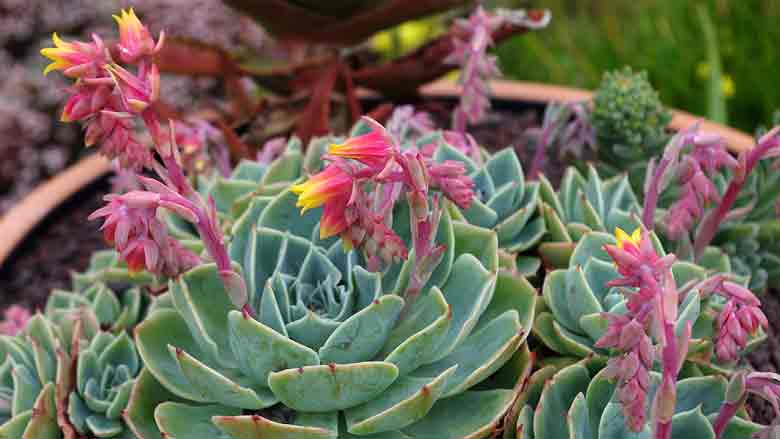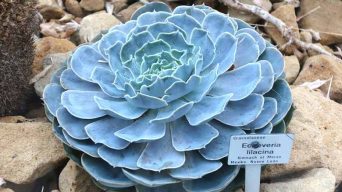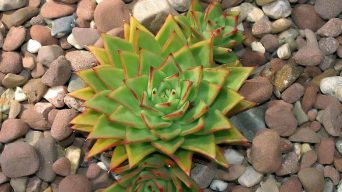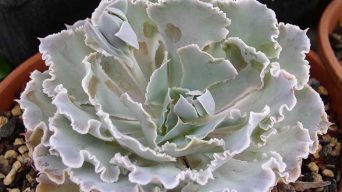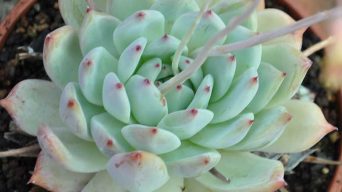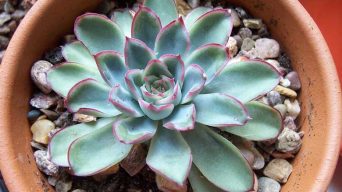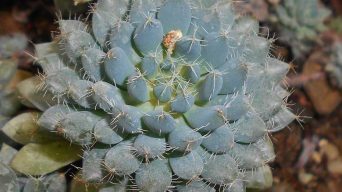Anyone who enjoys succulents and particularly Echeveria plants, will love cultivating Echeveria secunda specimens.
They are very easy to take care of and propagate will minimal effort on your part.
So, you get the joy of having interesting plants to decorate your home or office space while not worrying too much about how you treat them.
Once you know a few basic facts about these succulents, it will be easy to keep them thriving in your garden.
So keep reading and learn more about how to grow Echeveria secunda plants. You will soon have your little collection of these fantastic plants in no time!
Overview
Echeveria secunda, also known as Glaucous Echeveria or Blue Echeveria, is a succulent flowering plant in the Crassulaceae family native to Mexico.
It’s a succulent plant that produces lovely clusters of tight, short-stemmed rosettes that may grow up to 6 inches (15 cm) in diameter.
Rosettes are made of fleshy, oval-shaped bluish-green leaves with pink or red on the edges and tips.
The flowers are larger than the rosettes and have red calyces and yellow petals, resulting in a bi-colored appearance.
The flowers bloom in late spring, which may grow up to 1 foot (30 centimeters) long on an arching stem.
Echeveria secunda is an excellent choice for rock gardens or container plants. It also makes an excellent groundcover for garden paths and beds.
How To Care for Echeveria Secunda
Echeveria secunda care should be about providing the conditions this succulent needs to thrive.
It has specific requirements to grow healthy and beautiful, so being familiar with these should never be neglected.
Below you’ll find the most important information you need to know about caring for Echeveria secunda.
Sun Exposure & Light Requirements
Echeveria secunda plants need full sun to partial shade.
Echeveria secunda prefers filtered light or partial shade but can adapt to full sun.
It’s best to place your Echeveria in a location with bright light but not in direct sunlight.
When indoors, keep your Echeveria secunda in a location with bright, indirect sunlight for at least five hours. West or east-facing windows are perfect for this.
All succulents like bright light, but direct sunlight can burn your Echeveria leaves and cause them to fall off or develop brown spots.
If you live in a hot climate, use caution with full sun exposure. Pay attention to your plant’s health. If it gets burned by the sun, take care to move it into a shadier area and be aware of any signs of sun damage.
Watering Requirements
Echeveria secunda will only need to be watered once every one or two weeks, depending on how hot it is, whether they are getting any direct sunlight, and how big the pot is.
It is essential to let all the soil become dry before the next watering, as overwatering can cause rot or fungal disease that can kill your succulent plant.
Water thoroughly so that the excess water is draining out of the pot, and let the soil dry out before the next watering.
The plant should be watered from below so that the water is not splashed onto the leaves and stems, which can cause fungal disease.
Ensure to empty any leftover water from the saucer after watering the plant, especially if using a clay pot.
This is to prevent too much water from building up in the bottom of the pot, which can cause root rot.
Soil Requirements
Your Echeveria secunda needs a well-draining planting mix. The best soil for it is a cactus potting mix.
However, since that may not be easy to get, you can use a regular potting mix that contains perlite and coarse sand. This will keep the soil loose, allowing the water to drain.
Don’t use heavy potting soil, which packs down and stays wet for weeks after watering.
A well-draining soil is important for any succulent plant, but it’s particularly important for Echeveria secunda. If the roots sit in water, the leaves may rot.
Temperature and Humidity
Echeveria secunda prefers to be in the temperature range between 15 and 23 degrees Celsius or 59-73 degrees Fahrenheit.
If you live below this temperature, try not to expose your plant to freezing temperatures. Also, try to avoid putting it in locations that are too hot.
If the temperature exceeds 30 degrees Celsius or 86 degrees Fahrenheit, the area becomes unsuitable for this plant as it can quickly die from the heat.
Humidity is another critical factor for Echeveria secunda to be healthy and growing.
It does best in dry environments, such as indoors, with 40% or less humidity. If the humidity is too high, it can cause fungal diseases.
If you live in an area where the humidity is not naturally dry, you should place your plant on a tray filled with stones and dried tangerine peels.
Fertilizing
Echeveria secunda is a succulent plant that does not need to be fertilized.
However, many plants can benefit from a balanced liquid fertilizer diluted to half-strength applied every two weeks during the growing season (i.e., spring and summer).
This succulent is sensitive to over-fertilization, so fertilizing sparingly is a good idea.
Potting and Repotting
Echeveria secunda plants are slow-growing succulents, so they only need to be repotted every two years.
Echeveria secunda can live in various containers, including plastic pots, wooden boxes, and ceramic containers.
However, unglazed or terracotta pots with drainage holes are the best choices.
The best way to care for them is to repot Echeverias as they outgrow their pots. You can move them into a bigger pot, but you should never put them in a smaller one.
When choosing a pot size for Echeveria secunda, make sure that the pot is at least 2.5″ (6 cm) larger than the original pot.
This will ensure that the soil does not dry out too quickly and that any excess moisture can drain away.
Pruning
Pruning off the bottom leaves is the only pruning required for the Echeveria secunda.
The lower leaves should be removed if they become dry, yellowed, or brown.
Dead areas on the leaves can also be cut off at any time by simply pinching them away with your fingers.
This helps give your Echeveria Secunda a clean look and helps prevent diseases and pests.
The leaves will be replaced with new growth on the top of the plant, so pruning does not affect the number or size of new leaves produced by the plant.
Pests and Diseases
Echeveria secunda succulent plant is a hardy little thing that manages to survive in most conditions. It does have some problems, though – while pests and diseases are rare, they could happen.
Pests
Spider Mites
Spider mites are pests that affect succulent plants like this one. They make small webs that can be seen on the leaves of the plant. If the plant is infested, you will notice that the leaves are losing their color and clarity.
If you suspect your plant is infested with spider mites, treat them with a small amount of Neem oil mixture.
The best way to deal with this is by simultaneously keeping the plant in quarantine for about two weeks and treating any other plants you own (or plan on owning).
Mealybugs
Mealybugs are visible to the naked eye. You will see small white balls, roughly 1 cm in size, between the crevices of the plants’ leaves that contain eggs and larvae (watch out for webs around them).
If you notice any mealybugs, take a cotton swab and soak it in isopropanol alcohol or plain rubbing alcohol. Scrub the leaves carefully to remove them.
Diseases
Fungal Diseases
If you do not give your plant enough light and too much water, it will contract a fungal disease (which is more like a parasite) called botrytis.
You can identify this by discoloration of the leaves or general yellowing of the whole plant. They may rot as well.
Botrytis affects all parts of the plant. Cut off any affected parts and treat your other plants with a fungicide to prevent its spread.
If you do not take action immediately, botrytis could kill your plant within a few days. If any rot or discoloration appears on the soil, throw it away and start over again with fresh soil.
Root Rot
Root rot is a disease that affects succulent plants, particularly those with small roots. Overwatering your plant for prolonged periods can lead to root rot.
You will see discoloration on the stem and leaves and wilting of the plant’s lower body.
In case you notice any symptoms, transplant your succulent plant to a bigger pot and stop watering it for two weeks – let the roots dry and heal. Water sparingly until then.
How to Care for Echeveria Secunda in Winter
The Echeveria secunda succulent resides in USDA zones 9-11, which means it needs to be taken indoors if you live in a colder area.
If you plan on keeping your plant inside for the winter (October-March), place it near a sunny window and water every two weeks.
This is because, during winter, most plants don’t receive enough sunlight and therefore don’t need as much water.
If you’re taking your Echeveria secunda outside, make sure the temperature is above 50°F (10°C) during summer and below 40°F (5°C) in winter.
How To Propagate Echeveria Secunda
Echeveria secunda succulents are so low-maintenance that it’s pretty easy to propagate them yourself.
The easiest way is by leaf cuttings, but you can also sprout new Echeveria secunda from seeds and stem cuttings.
Propagating Echeveria Secunda From Leaf Cuttings
To propagate Echeveria secunda using leaf cuttings:
- Carefully tear or cut off a leaf from the center of the plant. Leaves that are still growing and healthy will grow roots faster than leaves that aren’t.
- Let the leaf callous over for a couple of days. The callus is the dry, white stuff that forms on the cut surface.
- Lay the callused leaf on top of a cutting mix that’s been dampened, then cover the whole thing with a clear plastic bag. You’ll want to place this in a succulent propagation tray or something similar.
- Stick the whole thing in a warm, bright location and wait for it to grow roots. The leaves will start rooting in about 2-3 weeks.
- Remove the plastic bag after the roots have grown well, then plant your new Echeveria secunda succulent in a succulent planter or outdoor soil.
Propagating Echeveria Secunda From Seeds
It’s also possible to propagate Echeveria plants using mature seeds. To do this:
- Collect the seeds. You can do this by carefully cutting off the flowers, then waiting for them to dry and turn brown (usually takes about two weeks).
- Plant the seeds. First, use a pencil or something similar to make tiny holes in the soil (the holes should be big enough to fit the seeds). Then, lightly sprinkle them over the soil.
- Wait for the seeds to germinate and grow into seedlings, then transplant your new Echeveria secunda succulent from its seed shell into a bed of succulent soil.
Propagating Echeveria Secunda From Stem Cuttings
Another way to propagate Echeveria secunda is by taking stem cuttings. To do this:
- Cut a few inches from the end of a healthy stem. You can either use a clean, sharp blade or scissors to do this.
- Let your Echeveria secunda succulent callous over for a few days before you plant it in soil. The callus is the dried white stuff that forms on the cut surface.
- Use a general succulent soil or cactus soil mix for this.
- Stick the Echeveria secunda cutting in the soil so that about 1 or 2 inches is still above ground. Water the soil so it stays damp but not soaking wet.
- Keep your Echeveria secunda cutting in a bright area and wait for roots to grow. This will usually take about 2-3 weeks.
- Transplant your new succulent into a pot once the roots have grown well, then water it regularly until it’s well-established.
Final Thoughts
Growing Echeveria secunda plants is a rewarding and low-maintenance hobby.
Providing these succulents with the proper care will make them easily last inside for years.
The most important thing to remember is that these plants are not very demanding.
You can quickly learn how to take care of Echeveria secunda even if you have never cultivated a plant before.

